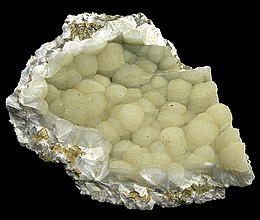
Actinolite is an amphibole silicate mineral with the chemical formula Ca2(Mg4.5–2.5Fe2+0.5–2.5)Si8O22(OH)2.

Pyrophyllite is a phyllosilicate mineral composed of aluminium silicate hydroxide: Al2Si4O10(OH)2. It occurs in two forms (habits): crystalline folia and compact masses; distinct crystals are not known.
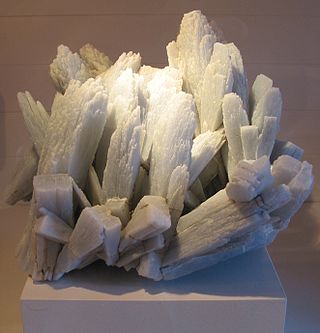
Anhydrite, or anhydrous calcium sulfate, is a mineral with the chemical formula CaSO4. It is in the orthorhombic crystal system, with three directions of perfect cleavage parallel to the three planes of symmetry. It is not isomorphous with the orthorhombic barium (baryte) and strontium (celestine) sulfates, as might be expected from the chemical formulas. Distinctly developed crystals are somewhat rare, the mineral usually presenting the form of cleavage masses. The Mohs hardness is 3.5, and the specific gravity is 2.9. The color is white, sometimes greyish, bluish, or purple. On the best developed of the three cleavages, the lustre is pearly; on other surfaces it is glassy. When exposed to water, anhydrite readily transforms to the more commonly occurring gypsum, (CaSO4·2H2O) by the absorption of water. This transformation is reversible, with gypsum or calcium sulfate hemihydrate forming anhydrite by heating to around 200 °C (400 °F) under normal atmospheric conditions. Anhydrite is commonly associated with calcite, halite, and sulfides such as galena, chalcopyrite, molybdenite, and pyrite in vein deposits.
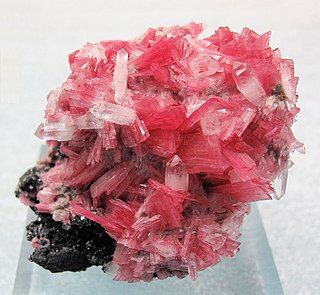
Rhodonite is a manganese inosilicate, with the formula (Mn, Fe, Mg, Ca)SiO3, and member of the pyroxenoid group of minerals, crystallizing in the triclinic system. It commonly occurs as cleavable to compact masses with a rose-red color (its name comes from Ancient Greek ῥόδον (rhódon) 'rose'), often tending to brown due to surface oxidation. The rose-red hue is caused by the manganese cation (Mn2+).

Aegirine is a member of the clinopyroxene group of inosilicate minerals. It is the sodium endmember of the aegirine–augite series. It has the chemical formula NaFeSi2O6, in which the iron is present as the ion Fe3+. In the aegirine–augite series, the sodium is variably replaced by calcium with iron(II) and magnesium replacing the iron(III) to balance the charge. Aluminum also substitutes for the iron(III). Acmite is a fibrous green-colored variety.

Larimar is the tradename for a rare blue variety of the silicate mineral pectolite found only in the Dominican Republic, around the city of Barahona. Its coloration varies from bluish white, light-blue, light-green, green-blue, turquoise blue, turquoise green, turquoise blue-green, deep green, dark green, to deep blue, dark blue and purple, violet and indigo and the larimar can come in many varieties and color mixes.
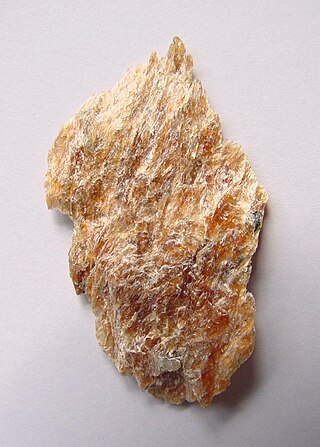
Yuksporite is a rare inosilicate mineral with double width, unbranched chains, and the complicated chemical formula K4(Ca,Na)14Sr2Mn(Ti,Nb)4(O,OH)4(Si6O17)2(Si2O7)3(H2O,OH)3. It contains the relatively rare elements strontium, titanium and niobium, as well as the commoner metallic elements potassium, calcium, sodium and manganese. As with all silicates, it contains groups of linked silicon and oxygen atoms, as well as some associated water molecules.
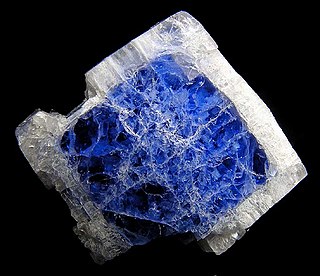
Carletonite is a rare silicate mineral with formula KNa4Ca4(CO3)4Si8O18(F,OH)·(H2O).

Stillwellite-(Ce) is a rare-earth boro-silicate mineral with chemical formula (Ce,La,Ca)BSiO5.

Tuperssuatsiaite is a rare clay mineral found in Greenland, Namibia and Brazil. It is a hydrated phyllosilicate of sodium and iron.

Serandite is a mineral with formula Na(Mn2+,Ca)2Si3O8(OH). The mineral was discovered in Guinea in 1931 and named for J. M. Sérand. Serandite is generally red, brown, black or colorless. The correct name lacks an accent.

Narsarsukite is a rare silicate mineral with either the chemical formula Na2(Ti,Fe3+)Si4(O,F)11 or Na4(Ti,Fe)4[Si8O20](O,OH,F)4.
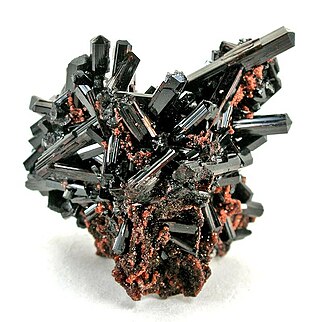
Manganvesuvianite is a rare mineral with formula Ca19Mn3+(Al,Mn3+,Fe3+)10(Mg,Mn2+)2(Si2O7)4(SiO4)10O(OH)9. The mineral is red to nearly black in color. Discovered in South Africa and described in 2002, it was so named for the prevalence of manganese in its composition and its relation to vesuvianite.
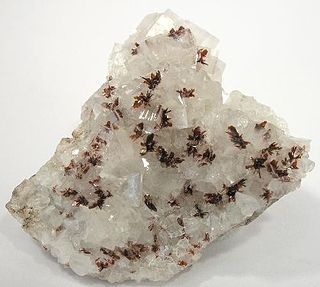
Ruizite is a sorosilicate mineral with formula Ca2Mn2Si4O11(OH)4·2H2O. It was discovered at the Christmas mine in Christmas, Arizona, and described in 1977. The mineral is named for discoverer Joe Ana Ruiz.
Feklichevite is a rare mineral of the eudialyte group with the formula Na11Ca9(Fe3+,Fe2+)2Zr3NbSi(Si3O9)2(Si9O27)2. The original formula was extended to show the presence of cyclic silicate groups and presence of silicon at the M4 site, according to the nomenclature of eudialyte group. When compared to other minerals of the group, feklichevite characterizes in the presence of ferric iron (thus similar to ikranite, mogovidite and fengchengite) and dominance of calcium at the N4 site. Calcium is ordered in the structure and is also present at the M1 site. Other iron-bearing minerals of the group are eudialyte, ferrokentbrooksite, georgbarsanovite, khomyakovite, labyrinthite, oneillite and rastsvetaevite, but they rather contain ferrous iron Feklichevite name honors Russian mineralogist and crystallographer, V. G. Feklichev.
Mogovidite is a very rare mineral of the eudialyte group, with formula Na9(Ca,Na)6Ca6(Fe3+,Fe2+)2Zr3[]Si(Si9O27)2(Si3O9)2(CO3)(OH,H2O)4. The formula given is based on the original one but extended to show the presence of cyclic silicate groups. It is similar to feklichevite, differing from it in the presence of essential vacancies and carbonate group. Another specific feature is the dominance of ferric iron – a feature shared with other eudialyte-group members, including feklichevite, fengchengite, golyshevite and ikranite. Similarly to golyshevite, it is calcium-dominant, however on three sites: M(1), N(3) and N(4). It has a molecular mass of 3,066.24 gm.
Faizievite is a very rare mineral with the formula K2Na(Ca6Na)Ti4Li6Si24O66F2. This triclinic mineral is chemically related to baratovite and katayamalite. Faizievite is a single-locality mineral, coming from the moraine of the Darai-Pioz glacier, Tien Shan Mountains, Tajikistan. Alkaline rocks of this site are famous for containing numerous rare minerals, often enriched in boron, caesium, lithium, titanium, rare earth elements, barium, and others.

Inesite is a hydrous calcium manganese silicate mineral. Its chemical formula is Ca2Mn7Si10O28(OH)2•5(H2O). Inesite is an inosilicate with a triclinic crystal system. It has a Mohs hardness of 5.5 to 6, and a specific gravity of 3.0. Its name originates from the Greek Ίνες (ines), "fibers" in allusion to its color and habit.
Schizolite is a mineral with the formula NaCaMnSi3O8(OH) first described in 1901 after discovery in South Greenland by Winther. Its name comes from the Greek word 'σϗιζω' (sϗizo) after its perfect cleavage. It was dropped from the valid species status in 1955 as a variety of pectolite based on Schaller's work. It's a member of the Wollastonite group.
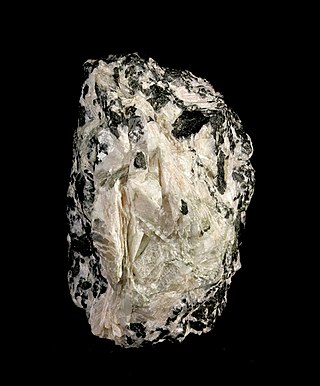
Baratovite is a very rare cyclosilicate mineral named after Rauf Baratovich Baratov from Tajikistan. It was discovered in 1974 at Dara-Pioz glacier, Tajikistan, and was approved by the International Mineralogical Association only a year later in 1975. The glacier gives home to 133 valid species, and is the type locality of 33 minerals, one of which is baratovite.
